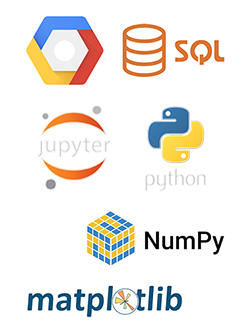
BRENT MARTIN
Data Scientist/ Business Intelligence Analyst / UI/UX Designer

Data Scientist/ Business Intelligence Analyst / UI/UX Designer
This project focuses on building predictive models to estimate Apple stock prices using various machine learning algorithms. We have implemented Linear Regression, Random Forest, Gradient Boosting, and an LSTM Neural Network to forecast Apple’s stock price based on historical data. The models were evaluated based on performance metrics like R-squared and Mean Squared Error, with Gradient Boosting and Random Forest achieving the highest accuracy. The goal is to identify trends and assess the reliability of these models in predicting future Apple stock movements, showcasing the utility of machine learning in financial forecasting.
Navigate to Explore Project Pages, View Visualizations and Dashboards, and Open Jupyter Notebooks:


PROJECT GLOSSARY:
COMING SOON – follow links to read informative blog posts:

The Linear Regression model was trained using historical Apple stock data, utilizing key features like past stock prices to predict future stock prices. The model achieved an excellent R-squared score of 0.99, indicating a nearly perfect fit for the training data. The Mean Squared Error (MSE) was around 0.83, reflecting a relatively low error between the actual and predicted prices. However, despite the high R-squared value, the linear regression model tends to struggle with capturing the volatile nature of stock prices, especially during periods of rapid price fluctuations. This model is most effective in identifying general trends over a longer timeframe, rather than short-term market movements. The plot compares the actual Apple stock price against the predicted price to visualize this performance.
The Random Forest model was trained to predict Apple stock prices using various features like daily return, moving averages, and volatility. The model’s performance, evaluated using the Mean Squared Error (MSE) and R-squared, showed a strong ability to fit the data, with a Mean Squared Error of 2.83 and an R-squared of 0.997. The model’s predictions closely tracked the actual stock prices, though some variance was observed in highly volatile periods.
In terms of feature importance, the Random Forest model highlighted that the most significant predictor was the ‘Previous Close’ price, followed by moving averages, with 30-day and 7-day MAs contributing more moderately. This shows that recent price behavior has the strongest influence on predicting future values, aligning with typical financial market behaviors where past performance heavily influences short-term price movements.
The Gradient Boosting Regressor was applied to predict Apple stock prices based on technical indicators like moving averages and daily returns. The model showed strong performance with an R-squared value of 0.9987 and a Mean Squared Error of 1.73, indicating a high degree of accuracy in fitting the test data. This method leveraged an ensemble of weak learners (decision trees) to create a strong predictive model. By combining the predictions of many weak models, Gradient Boosting is particularly effective in capturing nonlinear relationships in the stock data, making it a powerful tool for stock price prediction.
After hyperparameter tuning, the model achieved a Mean Squared Error of 1.32 and an R-squared value of 0.9990, indicating a further improvement in performance. Optimal parameters included 300 estimators, a learning rate of 0.1, and a maximum depth of 3 for the trees. The tuned model demonstrated superior accuracy and generalization ability.
The Long Short-Term Memory (LSTM) neural network was applied to predict Apple stock prices. The model was trained over 50 epochs with batch size set to 32, using the Adam optimizer. To ensure uniform scaling across all features, the StandardScaler was applied, which is particularly important for neural networks. The model achieved a Mean Squared Error (MSE) of 87.851 and an R-squared value of 0.937, indicating relatively good performance, though the predictions demonstrated some deviations from actual prices. The LSTM model was effective at capturing trends in stock prices due to its ability to remember sequential dependencies, but further tuning of hyperparameters (such as number of layers or epochs) might be required to improve accuracy.
This project focuses on predicting stock market movements using a variety of machine learning models, analyzing both the S&P 500 and FAANG stocks (Facebook, Amazon, Apple, Netflix, Google). By leveraging historical stock price data and key financial indicators, the project aims to forecast market direction and provide valuable insights for potential trade entries and exits.
The project applies advanced machine learning techniques such as Linear Regression, Random Forest, Gradient Boosting, and LSTM Neural Networks to predict stock prices. The models capture both short- and long-term trends, offering predictive insights that could be valuable to traders and investors.
A key part of the project involves the FAANG stock analysis, which leverages the same machine learning models to predict the price movements of some of the most influential companies in the market. By focusing on these stocks, the project demonstrates the application of machine learning to high-profile assets and highlights potential future market trends.
Client : N/A (Personal Project)
Date : September 2024
Category : Financial
Data Scientist/ Business Intelligence Analyst / UI/UX Designer